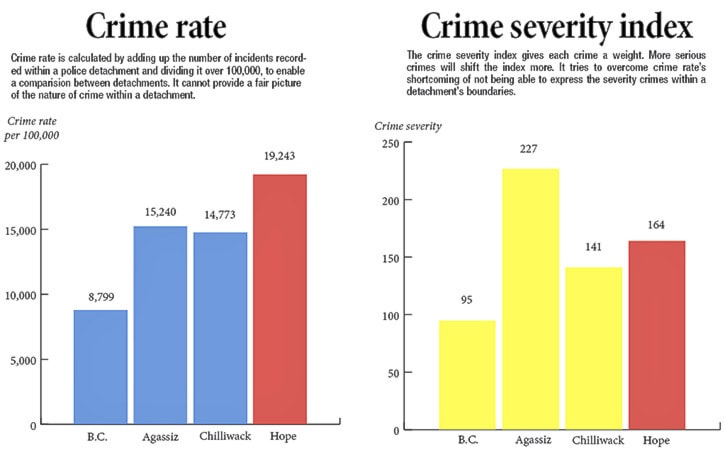New Statistics Canada data showed that the number of crimes committed within the Hope RCMP’s detachment boundaries, which includes Yale, has increased but the severity of crimes has decreased.
Released last Wednesday, the data showed that the area’s crime rate has gone up by 23 per cent in 2015, compared to 2014.
In 2014, there were 187 incidents, whereas in 2015, there were 234 incidents.
“Incidents” refer to crimes and offences that can be charged under a federal statute such as the Criminal Code, Controlled Drugs and Substances Act and Youth Criminal Justice Act.
Certain notable spikes in 2015 are in assaults, which jumped from 4 incidents in 2014 to 19 in 2015. Assaults that caused bodily harm or are done with a weapon went up from 4 to 6.
Property crime also increased from 91 incidents to 116. While break and enters fell from 17 to 12 incidents, carjacking went from 10 to 15 cases and theft under $5,000 went from 34 cases to 55.
Most notably, theft from a vehicle almost doubled with 31 cases as compared to 17 in 2014. Disturbing the peace also increased from 17 to 27 incidents.
Mischief, which encompasses vandalism, and drug possession crimes stayed mostly stable.
However, Statistics Canada’s data is not all doom and gloom, as it shows crime severity in Hope has gone down.
From 2014 to 2015, the crime severity index has gone down from 259 to 164 points, with a major drop in violent crime severity from 465 to 95 points.
To create the index, Statistics Canada assigns each violation a weight, based on the violation’s incarceration rate and the average length of imprisonment. Therefore, murders will shift the index more so than cannabis possession. The weighted offences are summed and then divided by the population.
The major drop in violent crime severity is likely attributable to there being no homicides or murders in 2015, whereas there was one homicide and a first-degree murder in 2014.
Hope RCMP detachment commander Staff Sgt. Karol Rehdner, who only came into his role last October, said that the detachment will continue targeted enforcement as part of their crime fighting strategy.
“Upper Fraser Valley Regional Detachment has two crime analysts who review all the incoming complaints made to police and track a variety of criminal offence areas,” said Rehdner in an email. “This analysis allows us to focus our efforts in specific areas. Targeted enforcement in essence.”
He further added that one means of executing targeted enforcement lies in the “street checks” program.
“Detachment members lead the entire UFVRD in street checks which is a proactive policing initiative to identify persons and their associates throughout the Hope area; primarily in the downtown core,” said Rehdner. “This has a direct relation to mitigating crime and/or identifying persons who may be committing crimes.”
Rehdner noted that he would like to see a decrease in theft from vehicles, and will continue educating the public, encouraging them to leave “personal items out of view and preferably not within their vehicles.”
“I am still displeased with the theft from motor vehicle numbers,” said Rehdner. “I am working with our detachment members to develop suitable operational plans to combat this.”
He noted that recently, police charged a man with multiple crimes, the most serious of them include theft of a vehicle, three counts of robbery and three counts of dangerous driving causing bodily harm.
District of Hope Mayor Wilfried Vicktor believes the police have been making headway in this regard.
“They had three fairly active offenders that they've managed to deal with in the court system, and [thus] not available to get involved in other mischief because they're being held,” said Vicktor.
But he reminds the public to keep their vehicles free of items and use a steering wheel lock.
“We can't leave valuables in vehicles. Don't leave your passport, don't leave your driver's licence, don't leave your wallet, change in the centre console. You just set yourself up as a target,” said Vicktor. “So when you see something on Facebook pertaining to a vehicle that was broken into where a backpack full of valuables was taken — it's sad, but somewhat predictable.”
Vicktor believes that high rents in the Vancouver area is leading to “mischief makers” moving out east.
“It's still a little cheaper here than it is down the Lower Mainland,” said Vicktor. “That has created a natural flow of people, the good and the bad variety.”
Fraser Valley Regional District Area B director Dennis Adamson believes that tough economic times have a direct link to the increase in theft.
“People maybe are economically challenged because there's no work around there, and that may be some of the reasons why petty thefts are going on,” said Adamson. “But most people I talk to feel very safe.”
Adamson believes the police are trying their best.
“Even though the statistics are saying that crime has increased, I feel confident that the RCMP are doing a great job. In fact I've talked to the staff sergeant and he's increased the presence in Area B.
“Instead of just driving along the highway, I've asked them to drive through the towns, so the citizens are feeling quite safe.”
Boston Bar
Statistics Canada has no data on the crime rate within the Boston Bar RCMP detachment’s boundaries, which start just north of Yale.
However, compared to 2014, the number of incidents has gone up from 109 to 118.
Violent incidents kept steady at 13 in both 2014 and 2015.
However, property crime increased from 40 cases to 63. The jump in this statistic mostly comes from break and enters, which has increased over four times from 5 incidents to 21.
Mischief, which encompasses vandalism, increased from 12 cases to 17 cases.
Theft, over and under $5,000, have fallen from 18 cases to 14 cases, however, theft from a vehicle has increased from three cases to five.
Statistics Canada did not record Boston Bar’s crime severity index.
